
Fireworks!
July 2, 2021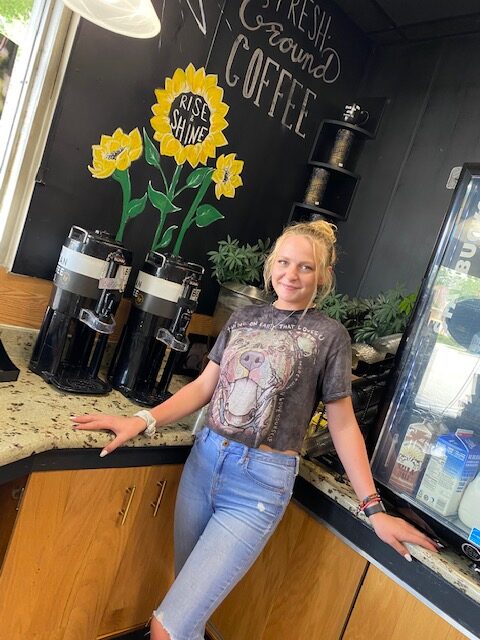
Get to Know – Kaylee Gelet – Deli on 4th
July 3, 2021History of a House – Reflecting back on a 65 Year History Of the Wells Fargo Bank Location
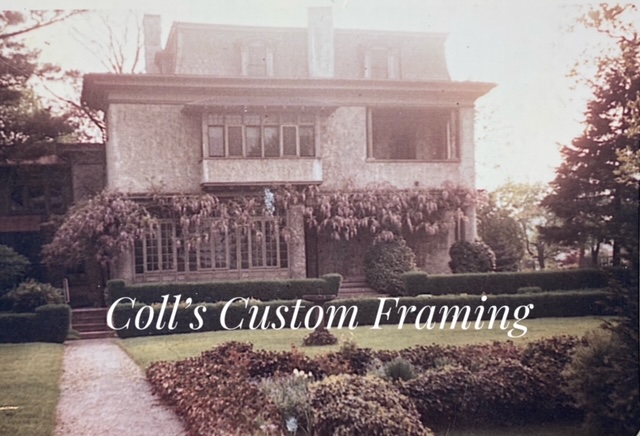
History of a House Series
Reflecting Back on a 65 Year History
Of the Wells Fargo Bank Location
By Jack Coll
6-25-21

I was standing in line at the Wells Fargo Bank located on the northwest corner at Fifth Avenue and Fayette Street with my grandson Rocco waiting to conduct business with the bank teller. (I’m thrilled that the lobbies of our local banks have reopened). I was staring at the beautiful history mural in the bank and thought back to when the bank first opened in 1956 at this location as The Philadelphia National Bank 65 years ago. I’m sure none of the current employees working for Wells Fargo are aware of the history of the bank or its location.
So I thought I would tell the history of the bank which includes the history of not one, but two long-gone houses that were demolished to make way for the bank’s location. So if you’re a fan of the “History Of A House” series, you might enjoy the history of a long gone, and long forgotten Conshohocken bank and the houses it claimed for their chosen location.
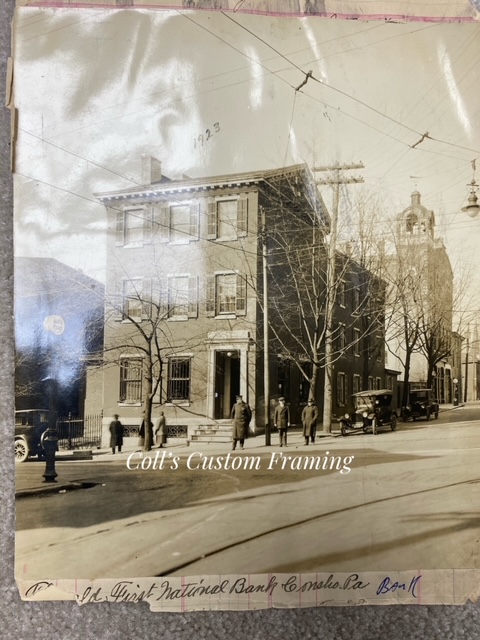
The Wells Fargo Bank currently located at Fifth Avenue and Fayette Street was established on March 2, 1852 by Henry Wells and William G. Fargo on the other side of the country in San Francisco, California. Since the foundation of the bank the Wells Fargo Corporation has gone worldwide. In 2008 Wells Fargo purchased the Wachovia Corporation changing the Conshohocken bank from Wachovia to Wells Fargo. Before Wachovia, there was First Union Bank, before that I believe it was CoreStates who bought out Philadelphia National Bank, who merged with The First National Bank of Conshohocken back in the mid 1950’s. It should be noted that The First National Bank of Conshohocken was the first small hometown bank to sell out Philadelphia National Bank. Other small community banks like Bridgeport National Bank, Phoenixville, and Norristown among others followed.
To trace the banks history and the two houses demolished to make way for the bank buildings we have to go back to the early days of Conshohocken. The village of Conshohocken in the 1830’s and 1840’s was a small village with very few residents. On May 5, 1832 James Wood and his son Alan opened a small mill and began rolling sheets of steel 18 inches in diameter and 36 inches in length for making shovel plates. The capacity of the rolls was 54 sheets in 12 hours. The Wood mill along the river was the first of many to follow.
On May 15, 1850 the village of Conshohocken was incorporated. The official incorporation documents arrived by train and it was reported that most of the 727 residents of the village were at the train station on that spring morning to watch the conductor of the train hand the incorporation papers to the Conshohocken postmaster Frederic Naile, the villages third postmaster, (the post office was established in 1836), before a cheering crowd Naile turned and handed the papers to the first Burgess John Wood who accepted the papers of incorporation making Conshohocken an official borough.
By 1870 the borough of Conshohocken had grown to more than 3,000 residents, the growth of the town forced housing and retail to move up the hill away from the river and industry was exploding along the river front. There was the Alan Wood Company, John Wood Company, Albion Print Works, S. Lees Cotton Mill, Schuylkill Iron Works, Schuylkill Woolen Mill owned by Horace Jones, Quigley Coal Shed, Conshohocken Tube Company, Lukens Rolling Mill and in the Spring Mill Section a couple of Terra Cotta Works owned by Scharff and Sons and William Moorehead.
With all the mills and factories it created a payroll problem. Sacks of money would arrive by train usually out of Philadelphia the day before payday giving the company’s time to sort out payroll payments.
So in the fall of 1872 a small group of businessmen led by Alan Wood Jr., began to talk about establishing a bank in Conshohocken. On January 30, 1873, an official charter was received and the Directors began to plan for the banks opening, the first order of business was to find a central location for the borough’s first bank.
A beautiful home owned by George Washington Jacoby located on the southwest corner of Hector and Fayette Street was the perfect location for a bank. Jacoby’s house was the town’s first pretentious three story brick building built with a long two story and basement addition facing Hector Street. The building was considered the borough’s first mansion and was host to many of town’s elite parties and was the center of social activities for this and surrounding communities.
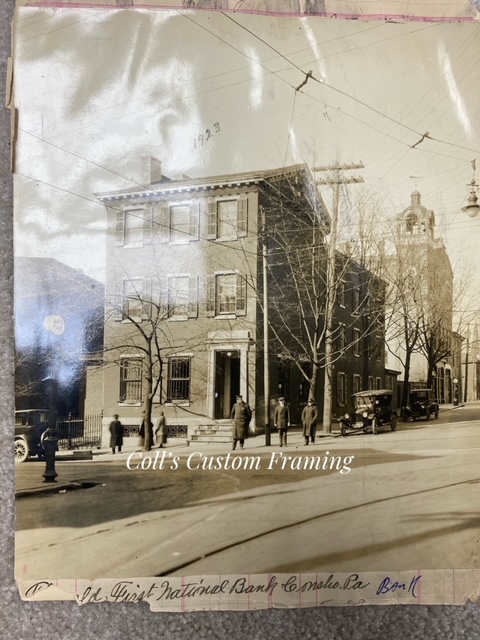
George Washington Jacoby was uncle and foster father to Samuel F. Jacoby, who was the 32nd Burgess of Conshohocken from 1897-1899. Samuel Jacoby’s daughter Mabel Jacoby was a well-known fixture in and around Conshohocken for many years.
Jacoby was a well-respected resident of Conshohocken and was a supervisor of the Marble cutting yard once located along the canal bank on the west side of the borough. Jacoby was more than happy to sell his house to the bank Board of Directors for a whopping $12,000, that’s $12,000 in 1873.
Alterations to convert the house into suitable banking quarters began immediately following the purchase. The alterations to the building included a living quarters in the back end of the building. And so began the story of The First National Bank of Conshohocken. Over the next fifty years from 1873 to 1923 the bank prospered and grew.
In December 1923 it was decided to demolish the old Jacoby building and construct a new more modern looking building with all the safe-guards of a modern bank. Of course members of the Hayes family, the last family to live in the rear of the old bank were forced to move into a hotel until they could secure a new home.
In February of 1924 demolition began on the Jacoby house, the bank moved to temporary quarters in the former Central Hotel building once located across the street at Hector and Fayette Street. A big safe was installed in the hotel building and the banking office was located in the old bar room.
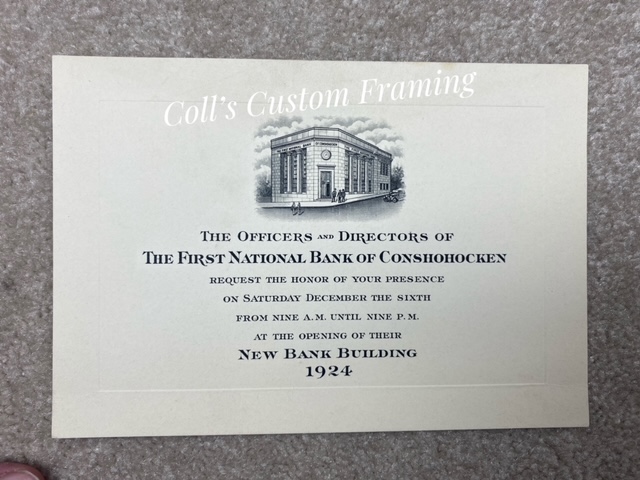
A Grand Opening of the new bank building was held ten months later on December 6, 1924, more than an estimated 7,500 residents and outsiders visited the bank to view the new marble structure. As a memento a cigar was given to each adult male visitor, a rose bud to each adult female visitor and a feather sticker to every child.

The bank continued to prosper and in 1948 the bank held a massive 75 year anniversary celebration. In 1953 under the bank presidency of Donald Horse, The First National Bank of Conshohocken after 80 years of service to the area merged with Philadelphia National Bank. Conshohocken was the first local national bank to sell out to PNB.

Shortly after the merger in 1953 plans were made to construct a new bank building in up-town Conshohocken and the Horace C. Jones mansion once located on the northwest corner of Fifth Avenue and Fayette Street was purchased in early 1954. (The site of the current Wells Fargo Bank)
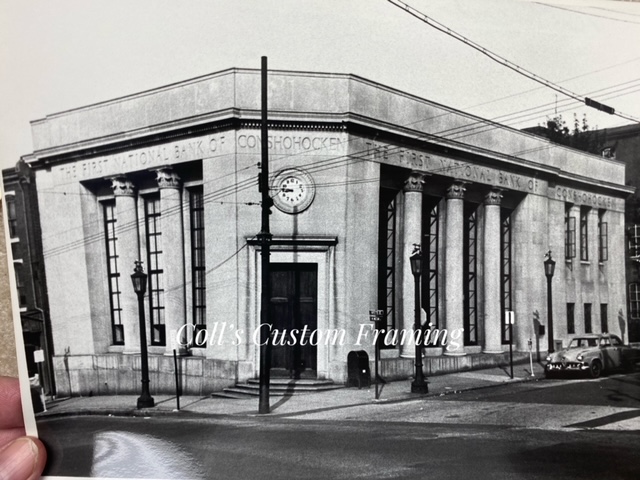
Horace C. Jones was the one time President of The First National Bank of Conshohocken who had purchased the mansion at Fifth Avenue and Fayette Street from William Perot, the mansion was built by David L. Wood, a member of Conshohocken’s first Town Council. Some reports have it that James Wood built the mansion), either way the mansion was built in 1880. David’s daughter Annie Wood later married William Sansom Perot and the corner mansion with its grounds extending a full square on Fayette Street became known as the “Perot Mansion.”

Following Annie’s parent’s death the Perot’s maintained the house and beautiful grounds and gardens and became known as a mecca of many Sunday afternoon strolls in the early part of last century. Following the death of the Perot’s, Horace and Linda Jones moved into the mansion, where they lived until their death in the early 1950’s.
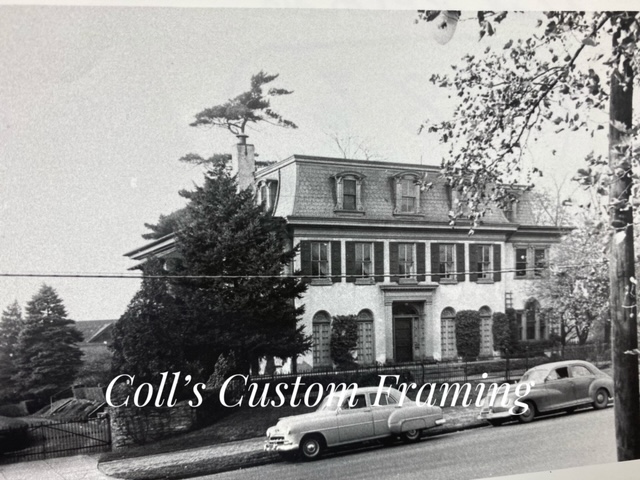
That set the stage in the spring of 1954 for the Philadelphia National Bank to acquire the Jones property and gardens, the gardens were well known for the rare plants and trees along the many levels of the property. The mansion and gardens sold for a cool $75,000 where they intended to build a bank and a modern shopping center along the rest of the block. Remember the Jones property included Fayette Street from Fourth Avenue to Fifth Avenue that would include where the current Borough Hall is located.

Once the property was purchased demolition began on the mansion and in the spring of 1956 the bank was open for business. David Fondots who was 14 years old and lived at 113 Maple Street was the very first person to open a savings account at the new bank.
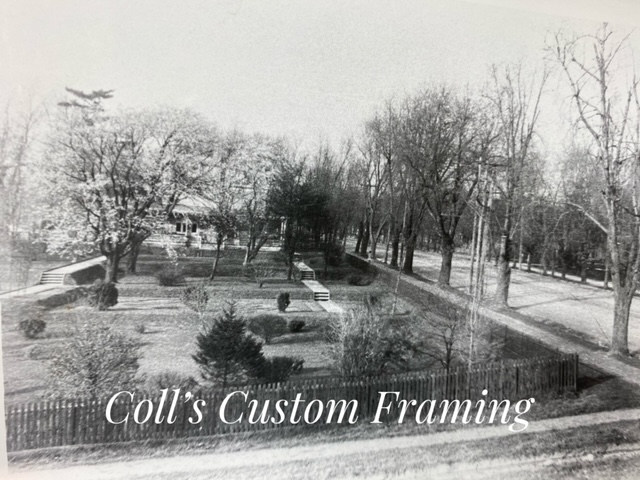
In 1924 upon the opening of the newly constructed Hector Street Bank the very first depositor in the bank was William Davis Jr., age 10 days, he was a grandson of Director Reese P. Davis and a great grandson of William Davis, one of the original stockholders in the bank.
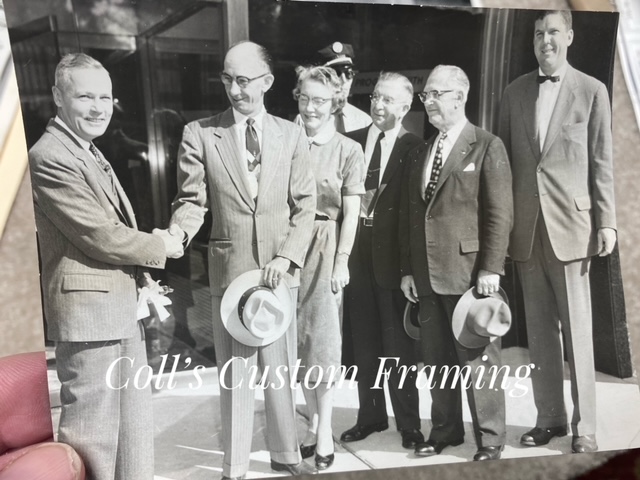

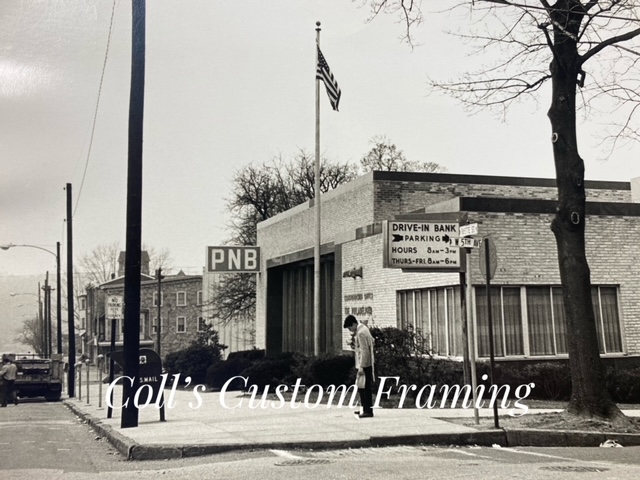
In the early 1990’s the merging game continued when Core States merged with PNB, followed by First Union, followed by Wachovia and finally Wells Fargo. (I think I got that right, feel free to correct me)

That brings me back to me standing in the lobby of the Wells Fargo Bank a couple of Friday’s ago with my grandson Rocco, looking up at that beautiful mural across the top of the bank and thinking it was 65 years ago that this building opened for banking business. (By the way if you are familiar with the mural in the bank the photographs were supplied by Coll’s Custom Framing)
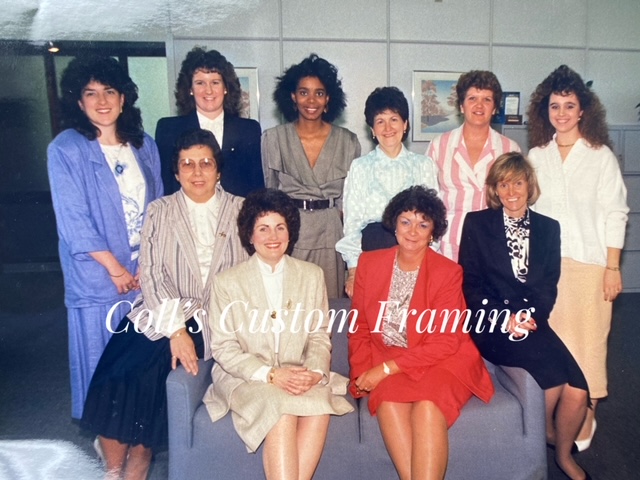
Along the way the banks took two houses to make way for their facility, has helped countless residents with their home and car loans among other things, been robbed a couple of times, survived two pandemics, countless wars, the demise of the borough’s industries, the loss of residents and the closing of schools and churches, and yet we still have a half of dozen banks to choose from and I can attest that every bank in town is more than happy to greet you and help you with your finances. Happy Banking!

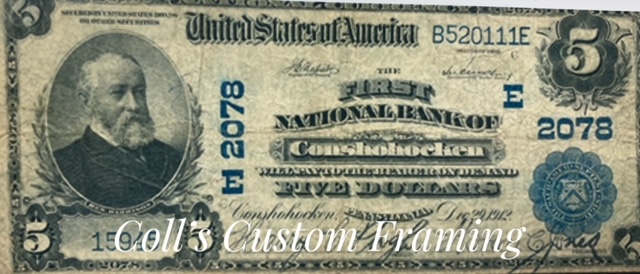
And Thanks for the Memories.
For more articles on “History Of A House” feel free to go to Conshystuff.com and click on articles by Jack Coll along with our other wonderful articles and photographs.
Check out the great Photo descriptions below
Exterior shot of the Wells Fargo Bank located at West Fifth Avenue and Fayette Street,
Photo taken in 2021
Photograph of the First National Bank of Conshohocken taken in 1923. The former home of George Washington Jacoby once located on the corner of West Hector and Fayette Street had been converted into a bank in 1873. On the left of the photo was a sign for Harts Cigar Store a very popular place of business back in the early part of last century. Notice the bars on the windows of the bank with the police officer standing out front and to the far right in the photo the Washington Fire House can be seen and to the far right was a building that would become the Forrest Theatre. Other things to notice in the photo include the old street lamp hanging across Fayette Street, the 1920 automobiles parked outside the bank and off in the distance on the far right is the steeple of St. Mary’s Church.
An invitation for the Grand Opening of the new First National Bank of Conshohocken building dated December 6, 1924.
An Interior shot of the First National Bank of Conshohocken back in the early days, you can notice the mill workers, secretaries, and businessmen of the day waiting to conduct business.
Another interior shot of the bank, notice the large vault door on the right.
An exterior shot of the First National Bank of Conshohocken once located at West Hector and Fayette Street taken in the 1950’s.
An exterior photograph of the First National Bank of Conshohocken celebrating 75 years of business in the borough, 1873-1948. Notice the old street lamp-post, the 1940’s automobiles and a sign barely visible tacked onto the telephone pole advertising “Donkey Baseball” being held at the Conshohocken Community Field. Donkey Baseball was a popular event for a number of years and that’s another story for another time.
A photo of the Jones mansion, (Former Perot and Wood mansion) once located at Fifth Avenue and Fayette Street, the house was demolished in 1955 to make way for the new and improved Philadelphia National Bank and current home of the Wells Fargo Bank.
The back of the old Jones mansion showing off some of the beautiful gardens.
A photograph taken around the turn of last century of the Perot mansion gardens, later the Jones mansion. The photograph was taken from West Fourth Avenue looking up Fayette Street showing the different levels of the garden. Fayette Street was an unpaved roadway when this photograph was taken. On the right across Fayette Street was one of the Lukens mansions and is currently the site of the Conshohocken Post Office.
The ribbon cutting ceremony at the Philadelphia National Bank in 1956 included Howard Wood on the far right, Donald Horsey on the left and Claudia Ramey in the center
Interior shot of the Philadelphia National Bank at Fifth Avenue and Fayette Street in 1956, the day the bank opened.
Exterior shot of the Philadelphia National Bank in 1964.
Employees of the First National Bank of Philadelphia taken in 1964
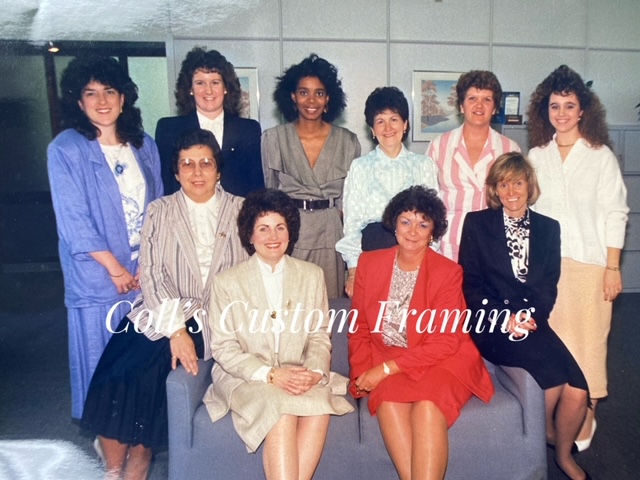
Employees of the First National Bank taken in 1989, seated from left included Angie Palermo, Susan Healy, Monica Iannamico and Sharon Johnson. Standing from left included Lori Alberta, Beth Gabel, Mellissa Dennis, Franny Frabezio, Laura Masico and April Battistoni.
Last photo include two Conshohocken Bank Notes from 1912 and 1929.
And that my friend is the history of two former Conshohocken houses, hope you enjoyed the journey thru time. Thanks for the memories!!

